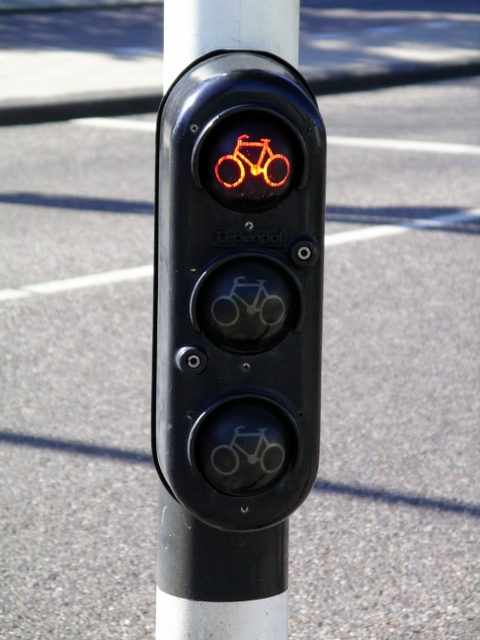As the streetscape around Broadway changes to accommodate heavier pedestrian, bicycle, and rail use, one significant issue that we need to address is how these modes of transport will intermingle with car traffic. SDOT is currently studying traffic patterns on Broadway to gain a grasp on feasibility of different route options along Broadway. If these studies do indicate that a plan like the one suggested by the CHCC works, it might be on our best interests to start thinking of ways to maximize safety in a road pattern that will be completely new to Seattle.
 An example of a bicycle traffic signal in Amsterdam.
An example of a bicycle traffic signal in Amsterdam.
One great way to maximize bicycle safety on our new cycle track would be to install bike specific traffic signals at major intersections. These signals work exactly like the ones for cars, but are timed so bicycles are using the intersection independent of other traffic. The basic setup, as seen in Amsterdam, goes something like this:
- Bike and car signals are red – pedestrians okay to cross
- Pedestrian and car signals are red – bikes have the intersection
- Bike and pedestrian signals are red – cars have the intersection
The use of these devices could minimize on safety concerns, as well as the age old driver gripe of “these bikes are always in my way!”
 A sign at the Market broadcasting the pedestrian right of way
A sign at the Market broadcasting the pedestrian right of way
As far as pedestrian matters go, proper signage is key for pedestrian safety on mixed rights of way. Signs placed in the drivers’ line of sight that clearly mark pedestrian right of way will be key. In this instance we do not have to look very far for inspiration. Seattle’s pedestrian/car/bicycle mixed use enclave, Pike Place Market, provides us with an excellent example of easy to understand and easy to see signage that could be used in similar projects around the city.
With minor improvements like this, the street has great potential be much more inviting to bicyclists and pedestrians alike. As planning progresses on this project, safety will definitely be a priority to continue to bring up at community meetings. So, I say why not start discussing openly now? Who doesn’t enjoy feeling safe, right? I would encourage anyone with ideas on safety improvements to add their ideas in the comments, as well as discussions throughout the community in general.
For more ideas on the reshaping of Capitol Hill’s streetscape, visit Open Alleyways.



I have never noticed the signs at the market.
For, that to really work, you’ll have to convince Seattle pedestrians that they are bound to obey traffic laws. Good luck with that.
MKK
Thanks for the ideas. New signals and signage will definitely be needed if (and still an if as far as I know) the cycle track happens on Broadway.
There is a nice local example of a bike signal in Fremont on the west approach to the bridge. My only concern with all of the separate light cycles you mention is that they require a lot of waiting for one’s turn. The Pike Market roadway is more of an example of chaotic coexistence at low speeds. I think the latter is often preferable.
Don’t you need to convince drivers to stop at intersections and crosswalks for pedestrians as well?
hah, me neither. seems like signage would do little to improve pedestrian safety…but maybe I’m wrong.
if you think pedestrians are the only one’s not obeying laws, you are living in a fantasy land. everyday i see motorists speeding (hey, 10 mph over the speed limit isn’t really speeding is it?) and failing to yield proper right of way.
generally though, most people obey the laws within reason. it is the egregious behavior that sticks in our minds. for me, it’s the overly aggressive driver. for you, apparently, it’s those menace to society, anarchist pedestrians. to each their own.
You also need to convince cyclists that a red light means stop.
Cyclists are the worst.
The idea of lower speed limits to facilitate mixed-use roads is a really compelling one. Even though it might not work in this context, the concept of the “woonerf” or living street (details here: http://en.wikipedia.org/wiki/Woonerf), which is popular in the Netherlands, makes streets equally welcoming for pedestrians, cyclists and motorists. By eliminating curbs and using lines or different paving treatments to create separate lanes, the woonerf makes everyone more aware of where they’re going and who they’re sharing space with.
This idea might not be a perfect fit in this context, but it’s possible that elements of it could help inform Broadway’s transformation.
I really love the idea of the woonerf, and this is sort of what I want to lobby for on Broadway between John and Pine. They work incredibly well in Amsterdam, minus dodging cyclists. So, having a woonerf/cycle track combo is definitely what I would really love to see on Broadway.
Signage at the Market SUCKS! The intersection at 1st & Pike is a great example of one that operates in an unusual fashion.
Too many tourists and suburbanites, who only come through there occasionally, have no expectation that the Walk signal doesn’t follow the car signals.
I’ve been trying for ages to get the City to install “All Ways” pedestrian signal signs like the West Seattle Junction has had for years.
You’re suggesting that Seattle looks to other cities for successful project design such as signage? And also ask that they look at safety for people and not vehicle and corporate interests? Like EVERYTIME there is a construction project and we lose our sidewalks so equipment can be parked on the sidewalks forcing us out on the street.